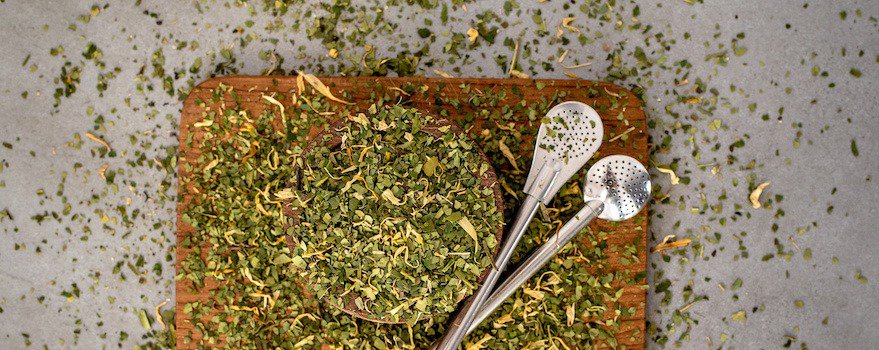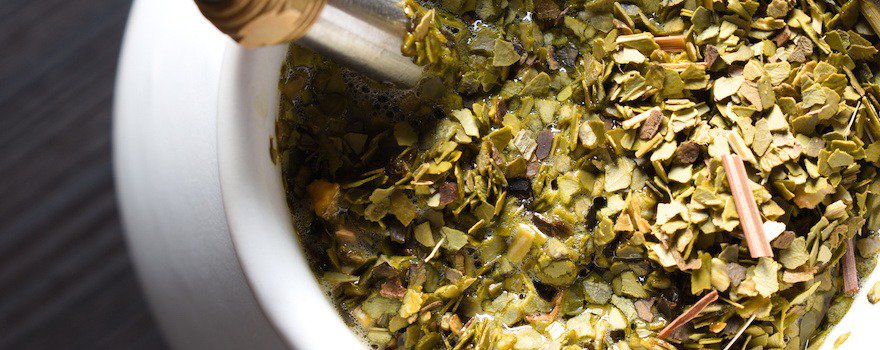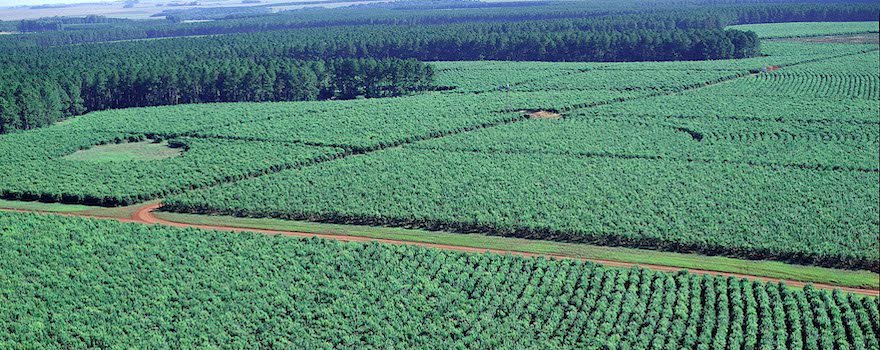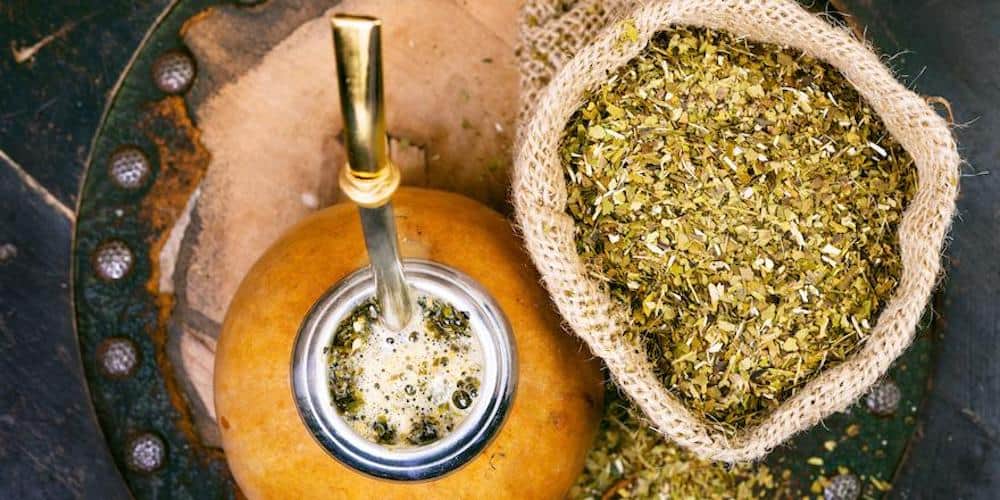BENEFITS OF YERBA MATÉ
✓ Improves alertness and combats fatigue
✓ A powerful antioxidant
✓ Promotes weight loss
✓ Protects the body from infections
✓ Helps fight hypercholesterolemia
What is Yerba Maté?
Yerba maté is also known as “Paraguay tea” or “Jesuits’ tea”. However, the plant is not from the same family as the tea plant. Yerba maté (in Latin, Ilex Paraguariensis) comes from a typically South American species of the holly family. It is a shrub of the Aquifoliaceae family whose leaves are used, once dried, to produce yerba maté.
It is primarily cultivated in Argentina and Paraguay, and it is also most consumed there: it is the favorite beverage of the South of South America, from Brazil to Chile. Residents drink it throughout the day in a thermos or, more traditionally, in a gourd with a perforated straw.

The term maté refers to the beverage, and yerba maté to the dried herb itself. Maté is traditionally consumed by the Guarani Indians (also big consumers of guarana) who inhabited the lands of South America before the arrival of the colonists. Explorers, hearing about a “drink that brings happiness“, made it known in Spain where it became very popular. The Jesuits, settled in Paraguay, then began cultivating the plant in the 16th century.
It is true that maté has an uplifting effect due to the caffeine it contains – about 1%: less than coffee, but more than green tea. It also contains theobromine, a substance also found in cacao that provides a feeling of well-being.
Yerba maté is nutritionally interesting: it provides many nutrients and vitamins without calorie intake, and it hydrates the body when consumed as an infusion.
Saponosides give maté its bitter taste, but they are also what provide its anti-cholesterol benefits.
Nutritional Composition
- Active substances that are stimulating: xanthines, caffeine, theobromine
- Anti-inflammatory and antioxidant compounds: flavonoids, saponosides, and polyphenols
- Vitamins A, B and C, magnesium, and calcium
- 7 out of the 9 amino acids the body needs

The Benefits of Yerba Maté
⚡️ Improves alertness and combats fatigue
Yerba maté is a powerful anti-fatigue agent. It’s of course the caffeine it contains that gives it this property.
Caffeine consumption helps fight fatigue and drowsiness and improves alertness during physical or mental efforts.
The Guarani Indians traditionally consume maté for this effect, and scientific studies have corroborated this virtue.
This meta-analysis of 41 scientific studies conducted on humans and published by the British Nutrition Foundation shows that even a moderate dose of caffeine has positive effects on mood, cognitive and physical performance, and perception of fatigue.
🥝 A powerful antioxidant
Maté has antioxidant properties slightly superior to those of green tea, which is already known for its antioxidant power. Thus, it allows the body to fight against cellular aging: a powerful ally from both a health and cosmetic perspective.
This published study by the University of Illinois compared the antioxidant capacities of green tea, maté, and an African plant, Ardisia Compressa. The researchers showed that the dried leaves of yerba maté had polyphenolic compounds and a high antioxidant capacity.
🏃🏻♂️ Promotes weight loss
Caffeine is found as an ingredient in many fat-burning products, to combat cellulite or to achieve a flat stomach.
Indeed, it plays both as an appetite suppressant and encourages the body to burn more calories during physical exertion.
One will not regain their figure solely by consuming yerba mate, but it can help promote weight loss as a complement to regular physical activity and a balanced diet.
This Swiss study conducted by the University of Lausanne with men and women showed that among several plant extracts, mate had the most impact on the treatment of obesity.
🛡 Protects the body from infections
The high content of polyphenols in yerba mate allows the body to better fight against inflammation and infections.
This American study conducted by the University of Tennessee-Knoxville showed that a high amount of yerba mate could fight against the E. Coli bacteria, responsible for food poisoning and diarrhea. This other study conducted in 2007 by researchers at the University of Illinois shows it could have an impact on fighting intestinal parasites.
However, these are only studies conducted in the laboratory, and more extensive research should be conducted to corroborate these effects.
🍳 Helps fight hypercholesterolemia
Its antioxidant compounds help protect the body from cardiovascular diseases and fight against hypercholesterolemia.
This study conducted with 100 people in 2009 by researchers from the University of Santa Catarina in Brazil showed that consuming 4 cups of yerba mate over 40 days reduced patients’ levels of “bad” cholesterol (LDL) by 8.6 to 13%.
How to consume yerba mate?
The consumption of mate in South America

Yerba mate, also called erva mate or chimarrão in Brazil, is consumed hot or cold depending on the region. It is traditionally drunk in a gourd (the mate) with a perforated straw. It can be consumed pure or mixed with other herbs, as in Paraguay where it is drunk with chamomile and anise.
Some also add milk or lemon juice. It can also be found in infusion bags like herbal tea. In South America, mate is drunk at any time of day, alone or in a group as a ritual beverage.
Consuming yerba mate as a superfood

In France, one can adopt the traditional consumption method or adapt it to our lifestyle. One can consume yerba mate as an infusion, with boiling water.
However, be careful, drinking mate too hot with the traditional straw can cause burns to the mouth or esophagus.
Mate has a slightly bitter flavor that may please or displease depending on tastes. Sugar can be added, but this loses the slimming effect of yerba mate.
Yerba mate is sold pure in the form of dried and chopped leaves. It is also available as a dietary supplement in capsules.
Sustainable consumption: prioritize organic and fair trade yerba mate
✓ It is preferable to buy organic yerba mate to avoid pesticide residues, especially since the leaves will be infused for a long time.
Also read Jérémie and Antoine want to replace coffee with their mate from the Paraná forests
✓ Intensive cultivation of mate can lead to deforestation in fragile areas of Paraguay, Brazil, and Argentina where it is most cultivated. One should prefer a product from agroforestry cultures to contribute to the sustainable development of production regions in South America. And if possible, from a fair trade industry to ensure a fair income for the producer.
Yerba mate dosage
It is better to consume yerba mate in the morning and at midday to avoid causing sleep disturbances due to its caffeine content. Specialists recommend consuming 4 cups a day to observe a health effect, i.e., 4 g of dried leaves per liter of water.
In capsule form, do not exceed 6 capsules per day. However, it is recommended to follow the advice of a naturopath if you want to undertake a yerba mate capsule treatment.
South Americans consume maté throughout their lives without it causing health issues. However, if someone is not accustomed to it, it is preferable not to exceed a 6-week course initially, to avoid creating a caffeine dependence.
Contraindications and side effects of yerba maté
Yerba maté should be consumed as a medicinal plant: it is important not to overuse it, as it could cause adverse side effects for the body.
- Excessive consumption of maté can cause sleep disturbances or stress. In any case, avoid consuming maté in the evening before going to bed. It is not recommended for individuals with heart conditions or those undergoing treatment for cardiovascular issues.
- Similarly, while yerba maté has a laxative effect and aids digestion, it can cause diarrhea if consumed in excessive amounts. In any case, adhere to the indicated dosage.
- It is strongly advised not to consume maté mixed with ephedra, another stimulating plant, as it may cause severe heart issues.
History, culture, and market of yerba maté

Yerba maté is an herb that is part of the pharmacopoeia and ritual ingredients of the Guarani Indians. Initially, it was consumed by chewing. Its consumption in the form of an infusion came later. Legend has it that an old Guarani chief, who could no longer keep up with his tribe’s migrations due to his advanced age, was left behind with his daughter. To help her father keep up with the tribe, she prepared a remedy based on yerba maté.
When the Spanish colonists arrived around 1500 near the Rio de la Plata, they noticed that the Guarani Indians were truly addicted to this plant. It wasn’t long before they tried it and incorporated it into their daily lives. The first recorded contact of the Spaniards with yerba maté dates back to 1554.
The Jesuits then started cultivating it and exporting the plant to Paraguay and northern Argentina: some missions became wealthy through the trade of this plant.
Today, this plant almost no longer exists in the wild due to intensive deforestation occurring in the south of the continent. The primary forest, the mata atlântica, now only exists in traces.
The intensive cultivation of yerba maté is also a cause of this deforestation: conventional maté (non-organic) is indeed cultivated in monoculture with extensive pesticide use. A more environmentally friendly and forest-conscious cultivation of yerba maté is being developed: it is recommended.
Report prepared by Pauline Petit and Charlotte Jean
Sources and scientific studies
Sonia Chandra, Elvira De Mejia Gonzalez, 2004, Polyphenolic compounds, antioxidant capacity, and quinone reductase activity of an aqueous extract of Ardisia compressa in comparison to mate (Ilex paraguariensis) and green (Camellia sinensis) teas.
A Martinet, K Hostettmann, Y Schutz, 1999. Thermogenic effects of commercially available plant preparations aimed at treating human obesity.
Kellie P Burris, P M Davidson, C Neal Stewart Jr, S Zivanovic, F M Harte, 2012. Aqueous extracts of yerba mate (Ilex paraguariensis) as a natural antimicrobial against Escherichia coli O157:H7 in a microbiological medium and pH 6.0 apple juice.
C I Heck , E G de Mejia, 2007. Yerba Mate Tea (Ilex paraguariensis): a comprehensive review on chemistry, health implications, and technological considerations.
Elayne C de Morais, Aliny Stefanuto, Graziela A Klein, Brunna C B Boaventura, Fernanda de Andrade, Elisabeth Wazlawik, Patrícia F Di Pietro, Marcelo Maraschin, Edson L da Silva, 2009. Consumption of yerba mate ( Ilex paraguariensis ) improves serum lipid parameters in healthy dyslipidemic subjects and provides an additional LDL-cholesterol reduction in individuals on statin therapy.



